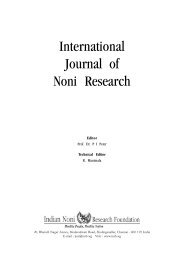International Journal of Noni Research - Noni Family
International Journal of Noni Research - Noni Family
International Journal of Noni Research - Noni Family
Create successful ePaper yourself
Turn your PDF publications into a flip-book with our unique Google optimized e-Paper software.
53 Intl. J. <strong>Noni</strong> Res. 2007, 2(1-2)<br />
D.R. Singh et al. Morinda citrifolia L. – An evergreen plant for diversification in commercial horticulture<br />
intensity <strong>of</strong> 44382 lux, maximum temperature (31.93 0 C), minimum<br />
temperature (27.03 0 C) and RH (77.1%) and also under shaded condition.<br />
The vegetative growth <strong>of</strong> plants were superior under open condition in terms<br />
<strong>of</strong> plant height (58.50 cm) with 4 branches and <strong>of</strong> reproductive growth with<br />
bud initiation on 32 days after planting and fruit production on 42 days after<br />
planting whereas the plants grown under shaded condition revealed to be<br />
having a height <strong>of</strong> 54.50 cm with 2 branches/plant.<br />
Effect <strong>of</strong> cow dung on sprouting <strong>of</strong> cuttings<br />
Within 13 days, 60% sprouting was observed after application <strong>of</strong> cow dung<br />
whereas in control the sprouting took about 15 days with 30% sprouting.<br />
Effect <strong>of</strong> hollow and non hollow cuttings on sprouting<br />
The findings <strong>of</strong> the study revealed that the sprouting initiated within15 days<br />
in case <strong>of</strong> non - hollow cuttings and 20 days in case <strong>of</strong> hollow cuttings. About<br />
50% sprouting was noticed in case <strong>of</strong> non - hollow cuttings and about 40%<br />
sprouting in case <strong>of</strong> hollow cuttings. Maximum (79.44%) plants were able to<br />
survive in case <strong>of</strong> non - hollow cuttings whereas in case <strong>of</strong> hollow cuttings<br />
the survival percentage was 62.78%.<br />
Phytochemical properties<br />
a) Nutrient composition<br />
The chemistry <strong>of</strong> <strong>Noni</strong> was investigated extensively by various scientific groups.<br />
A plethora <strong>of</strong> phytochemical constituents have been identified in the leaves,<br />
bark, stem, flowers and fruits <strong>of</strong> the plant. <strong>Noni</strong> fruit specifically is a rich<br />
source <strong>of</strong> phytochemical constituents, which demonstrate bioactivity.<br />
The fruit <strong>of</strong> Morinda citrifolia L. is a powerful detoxifier. It removes the<br />
toxins from cells <strong>of</strong> our body. It builds and strengthens every cell <strong>of</strong> our body<br />
to stay healthy. <strong>Research</strong>ers have discovered more than 150 neutraceuticals<br />
in the fruit <strong>of</strong> Morinda citrifolia L. <strong>Noni</strong> fruits appear to stimulate the<br />
production <strong>of</strong> T-cells, macrophages and thymocytes, thereby enhancing immune<br />
function. And in animal studies, <strong>Noni</strong> fruit extended the lives <strong>of</strong> mice with<br />
cancer.<br />
Various experimental studies were carried in the laboratory and the results<br />
revealed that in Morinda citrifolia L., Potassium, content was maximum in<br />
fruits (1226 ppm) followed by leaf (1219 ppm) while it was in very little in<br />
wood and bark. But in leaves, the calcium and magnesium contents were








